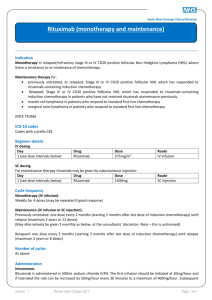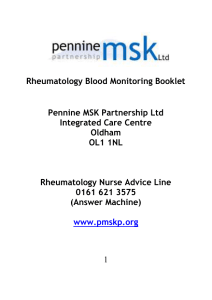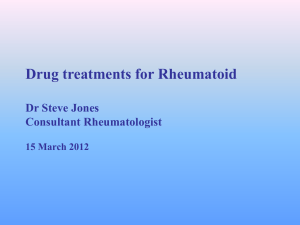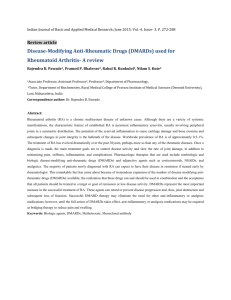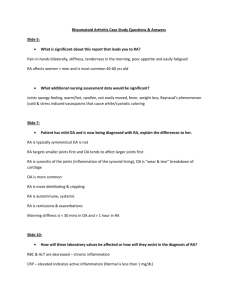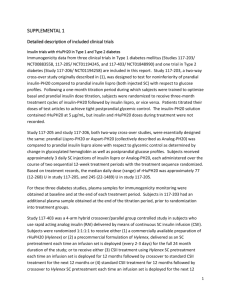ABATACEPT Template example
advertisement
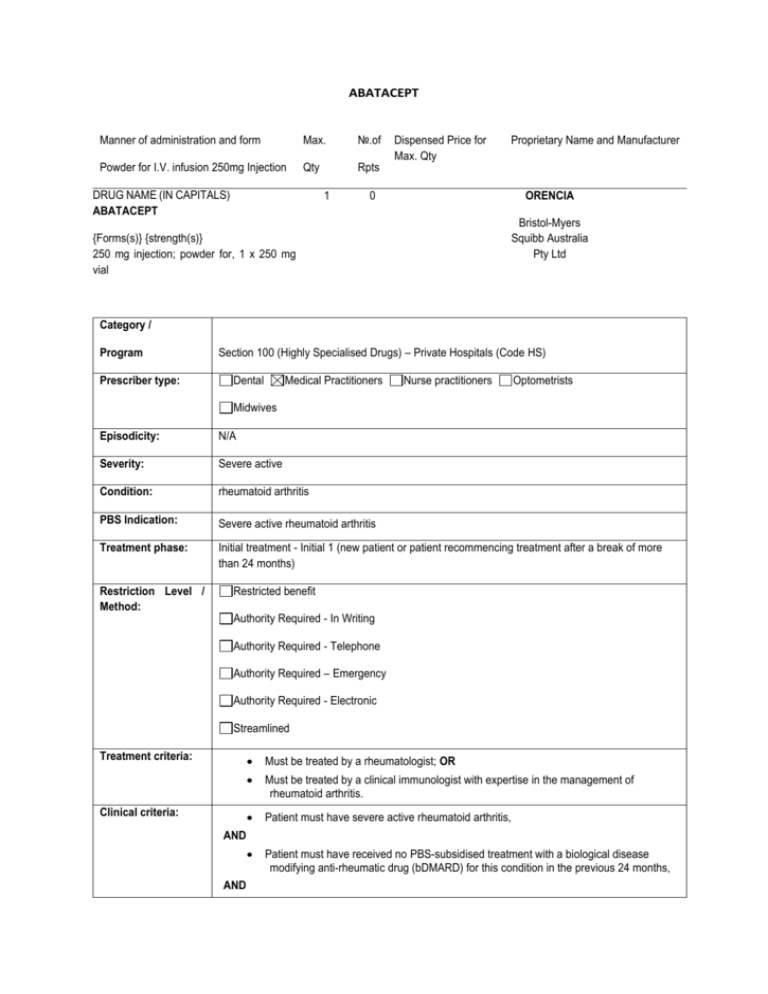
ABATACEPT
Manner of administration and form
Max.
№.of
Powder for I.V. infusion 250mg Injection
Qty
Rpts
DRUG NAME (IN CAPITALS)
ABATACEPT
1
Dispensed Price for
Max. Qty
Proprietary Name and Manufacturer
0
ORENCIA
Bristol-Myers
Squibb Australia
Pty Ltd
{Forms(s)} {strength(s)}
250 mg injection; powder for, 1 x 250 mg
vial
Category /
Program
Prescriber type:
Section 100 (Highly Specialised Drugs) – Private Hospitals (Code HS)
Dental
Medical Practitioners
Nurse practitioners
Optometrists
Midwives
Episodicity:
N/A
Severity:
Severe active
Condition:
rheumatoid arthritis
PBS Indication:
Severe active rheumatoid arthritis
Treatment phase:
Initial treatment - Initial 1 (new patient or patient recommencing treatment after a break of more
than 24 months)
Restriction Level /
Method:
Restricted benefit
Authority Required - In Writing
Authority Required - Telephone
Authority Required – Emergency
Authority Required - Electronic
Streamlined
Treatment criteria:
Must be treated by a rheumatologist; OR
Must be treated by a clinical immunologist with expertise in the management of
rheumatoid arthritis.
Clinical criteria:
Patient must have severe active rheumatoid arthritis,
AND
Patient must have received no PBS-subsidised treatment with a biological disease
modifying anti-rheumatic drug (bDMARD) for this condition in the previous 24 months,
AND
Patient must not have failed previous PBS-subsidised treatment with this drug for this
condition, and have not already failed, or ceased to respond to, PBS-subsidised
bDMARD treatment for this condition 5 times,
AND
Patient must have failed, in the 24 months immediately prior to the date of the
application, to achieve an adequate response to a trial of at least 6 months of intensive
treatment with disease modifying anti-rheumatic drugs (DMARDs) which must include
at least 3 months continuous treatment with each of at least 2 DMARDs, one of which
must be methotrexate at a dose of at least 20 mg weekly and one of which must be: (i)
hydroxychloroquine at a dose of at least 200 mg daily; or (ii) leflunomide at a dose of
at least 10 mg daily; or (iii) sulfasalazine at a dose of at least 2 g daily; OR
Patient must have failed, in the 24 months immediately prior to the date of the
application, to achieve an adequate response to a trial of at least 6 months of intensive
treatment with DMARDs which, if methotrexate is contraindicated according to the
Therapeutic Goods Administration (TGA)-approved Product Information or cannot be
tolerated at a 20 mg weekly dose, must include at least 3 months continuous
treatment with each of at least 2 of the following DMARDs: (i) hydroxychloroquine at a
dose of at least 200 mg daily; and/or (ii) leflunomide at a dose of at least 10 mg daily;
and/or (iii) sulfasalazine at a dose of at least 2 g daily; OR
Patient must have failed, in the 24 months immediately prior to the date of the
application, to achieve an adequate response to a trial of at least 6 months of intensive
treatment with DMARDs which, if 3 or more of methotrexate, hydroxychloroquine,
leflunomide and sulfasalazine are contraindicated according to the relevant TGAapproved Product Information or cannot be tolerated at the doses specified above,
must include at least 3 months continuous treatment with each of at least 2 DMARDs,
with one or more of the following DMARDs being used in place of the DMARDS which
are contraindicated or not tolerated: (i) azathioprine at a dose of at least 1 mg/kg per
day; and/or (ii) cyclosporin at a dose of at least 2 mg/kg/day; and/or (iii) sodium
aurothiomalate at a dose of 50 mg weekly,
AND
Patient must not receive more than 16 weeks of treatment under this restriction,
AND
The treatment must be given concomitantly with methotrexate at a dose of at least 7.5
mg weekly.
Population criteria:
Patient must be aged 18 years or older.
Foreword
N/A
Definitions
N/A
Prescriber
Instructions
For the purposes of this restriction bDMARD means abatacept, adalimumab,
certolizumab pegol, etanercept, golimumab, infliximab, rituximab or tocilizumab
If methotrexate is contraindicated according to the TGA-approved Product Information
or cannot be tolerated at a 20 mg weekly dose, the application must include details of
the contraindication or intolerance to methotrexate. The maximum tolerated dose of
methotrexate must be documented in the application, if applicable.
The application must include details of the DMARDs trialled, their doses and duration of
treatment, and all relevant contraindications and/or intolerances.
The requirement to trial at least 2 DMARDs for periods of at least 3 months each can
be met using single agents sequentially or by using one or more combinations of
DMARDs.
If the requirement to trial 6 months of intensive DMARD therapy with at least 2
DMARDs cannot be met because of contraindications and/or intolerances of a severity
necessitating permanent treatment withdrawal to all of the DMARDs specified above,
details of the contraindication or intolerance and dose for each DMARD must be
provided in the authority application.
The authority application must be made in writing and must include:
(1) a completed authority prescription form; and
(2) a completed Rheumatoid Arthritis PBS Authority Application - Supporting
information Form; and
(3) a signed patient acknowledgement.
At the time of authority application, medical practitioners should request the appropriate number
of vials to provide sufficient drug, based on the weight of the patient, for a single infusion. Up to
a maximum of 4 repeats will be authorised.
Assessment of a patient's response to an initial course of treatment must be made after at least
12 weeks of treatment so that there is adequate time for a response to be demonstrated. This
assessment, which will be used to determine eligibility for continuing treatment, must be
submitted no later than 1 month from the date of completion of this initial course of treatment.
Where a response assessment is not undertaken and submitted within these timeframes, the
patient will be deemed to have failed to respond to treatment with this drug.
Applications for a patient who has received PBS-subsidised treatment with this drug and who
wishes to re-commence therapy with this drug, must be accompanied by evidence of a response
to the patient's most recent course of PBS-subsidised treatment, within the timeframes specified
below.
Where the most recent course of PBS-subsidised treatment with this drug was approved under
either of the initial 1 or 2 treatment restrictions, the patient must have been assessed for
response following a minimum of 12 weeks of therapy. This assessment must be submitted no
later than 4 weeks from the date that course was ceased.
Where the most recent course of PBS-subsidised treatment with this drug was approved under
the continuing treatment criteria, the patient must have been assessed for response, and the
assessment must be submitted no later than 4 weeks from the date that course was ceased.
If a patient fails to demonstrate a response to treatment with this drug under this restriction they
will not be eligible to receive further PBS-subsidised treatment with this drug for this condition.
The following criteria indicate failure to achieve an adequate response and must be
demonstrated in all patients at the time of the initial application:
an elevated erythrocyte sedimentation rate (ESR) greater than 25 mm per hour or a C-reactive
protein (CRP) level greater than 15 mg per L; AND either
(a) a total active joint count of at least 20 active (swollen and tender) joints; or
(b) at least 4 active joints from the following list of major joints:
(i) elbow, wrist, knee and/or ankle (assessed as swollen and tender); and/or
(ii) shoulder and/or hip (assessed as pain in passive movement and restriction of passive
movement, where pain and limitation of movement are due to active disease and not irreversible
damage such as joint destruction or bony overgrowth).
The joint count and ESR and/or CRP must be determined at the completion of the 6 month
intensive DMARD trial, but prior to ceasing DMARD therapy. All measures must be no more
than one month old at the time of initial application.
If the above requirement to demonstrate an elevated ESR or CRP cannot be met, the
application must state the reasons why this criterion cannot be satisfied.
Where the baseline joint count is based on total active joints (i.e. more than 20 active joints),
response will be determined according to the reduction in the total number of active joints.
Where the baseline is determined on total number of major joints, the response must be
demonstrated on the total number of major joints. If only an ESR or CRP is provided with the
initial application, the same marker will be used to determine response.
Administrative
Advice
The Department of Human Services website (www.humanservices.gov.au) has details
of the toxicities, including severity, which will be accepted for the following purposes:
(a) exempting a patient from the requirement to undertake a minimum 3 month trial of
methotrexate at a 20 mg weekly dose;
(b) substituting azathioprine, cyclosporin or sodium aurothiomalate for another DMARD
as part of the 6 month intensive DMARD trial;
(c) exempting a patient from the requirement for a 6 month trial of intensive DMARD
therapy.
Special Pricing Arrangements apply.
Any queries concerning the arrangements to prescribe may be directed to the Department of
Human Services on 1800 700 270 (hours of operation 8 a.m. to 5 p.m. EST Monday to Friday).
Prescribing information (including Authority Application forms and other relevant documentation
as applicable) is available on the Department of Human Services website at
www.humanservices.gov.au
Applications for authority to prescribe should be forwarded to:
Department of Human Services
Prior Written Approval of Complex Drugs
Reply Paid 9826
HOBART TAS 7001
TREATMENT OF ADULT PATIENTS WITH SEVERE ACTIVE RHEUMATOID ARTHRITIS
The following information applies to the prescribing under the Pharmaceutical Benefits Scheme
(PBS) of the biological disease modifying antirheumatic drugs (bDMARDs) for adults with severe
active rheumatoid arthritis. Where the term bDMARD appears in the following notes and
restrictions it refers to the tumour necrosis factor (TNF) alfa antagonists (adalimumab,
certolizumab pegol, etanercept, golimumab, infliximab), the chimeric anti-CD20 monoclonal
antibody (rituximab), the interleukin-6 inhibitor (tocilizumab) and the T-cell co-stimulation
modulator (abatacept).
Patients are eligible for PBS-subsidised treatment with only 1 of the above biological disease
modifying anti-rheumatic drugs at any 1 time.
In order to be eligible to receive PBS-subsidised treatment with rituximab, a patient must have
already failed to demonstrate a response to at least 1 course of treatment with a PBS-subsidised
TNF-alfa antagonist.
A patient receiving PBS-subsidised bDMARD therapy may swap to an alternate bDMARD
without having to experience a disease flare. Under these interchangeability arrangements:
- a patient may continue to receive long-term treatment with a PBS-subsidised bDMARD while
they continue to show a response to therapy,
- a patient cannot trial and fail, or cease to respond to, the same PBS-subsidised bDMARD more
than once, and
- once a patient has either failed or ceased to respond to treatment 5 times, they will not be
eligible to receive further PBS-subsidised bDMARDs for the treatment of rheumatoid arthritis.
For patients who have failed PBS-subsidised treatment with 2 or 3 TNF-alfa antagonists prior to
1 August 2010 please contact the Department of Human Services on 1800 700 270.
A patient whose most recent course of PBS-subsidised therapy was with rituximab and whose
response to this treatment is sustained for more than 12 months, may apply for a further course
of rituximab under the Continuing treatment restriction. A patient who has failed fewer than 5
bDMARDs and who has a break in therapy of less than 24 months may commence a further
course of treatment with a bDMARD without having to requalify under the Initial 1 treatment
restriction. A patient who has failed fewer than 5 bDMARDs and who has had a break in therapy
of longer than 24 months must requalify for treatment under the Initial 1 treatment restriction.
The length of a treatment break is measured from the date the most recent treatment with PBSsubsidised bDMARD treatment is stopped to the date of the new application for treatment with a
bDMARD.
(1) How to prescribe PBS-subsidised bDMARD therapy after 1 August 2010.
(a) Initial treatment.
Applications for initial treatment should be made where:
(i) a patient has received no prior PBS-subsidised bDMARD treatment and wishes to commence
such therapy, excluding rituximab (Initial 1); or
(ii) a patient wishes to re-commence treatment with a bDMARD following a break in PBSsubsidised therapy of more than 24 months (Initial 1); or
(iii) a patient has received prior PBS-subsidised (initial or continuing) bDMARD therapy and
wishes to trial an alternate agent (Initial 2) [further details are under 'Swapping therapy' below];
or
(iv) a patient wishes to re-commence treatment with a specific bDMARD following a break of
less than 24 months in PBS-subsidised therapy with that agent (Initial 2).
Initial applications for new or re-commencing patients (Initial 1) must include a joint count and
ESR and/or CRP measured at the completion of the 6-month intensive DMARD trial, but prior to
ceasing DMARD therapy.
Initial treatment authorisations will be limited to provide a maximum of 16 weeks of therapy for
abatacept, adalimumab, etanercept, golimumab and tocilizumab, 18 to 20 weeks of therapy with
certolizumab pegol (depending upon the dosing regimen), 22 weeks of therapy for infliximab and
2 infusions of rituximab.
A patient must be assessed for response to any course of initial PBS-subsidised treatment
(excluding rituximab) following a minimum of 12 weeks of therapy and this assessment must be
submitted to the Department of Human Services no later than 4 weeks from the date that course
was ceased.
Rituximab patients must be assessed following a minimum of 12 weeks after the first infusion,
and this assessment must be submitted to the Department of Human Services within 4 weeks.
Where a response assessment is not submitted to the Department of Human Services within
these timeframes, the patient will be deemed to have failed to respond to treatment with that
bDMARD.
For second and subsequent courses of PBS-subsidised bDMARD (excluding rituximab)
treatment it is recommended that a patient is reviewed in the month prior to completing their
current course of treatment and that an application is submitted to the Department of Human
Services no later than 2 weeks prior to the patient completing their current treatment course.
Abatacept patients:
Patients are eligible to receive one I.V. loading dose when commencing treatment with the
subcutaneous formulation. For these patients two prescriptions are required, the first
prescription for the I.V. loading dose for sufficient vials for one dose based on the patient's
weight with no repeats. The second prescription for the pre-filled syringes, with a maximum
quantity of 4 and up to 3 repeats, must be submitted with the initial application.
Rituximab patients:
A further application may be submitted to the Department of Human Services 24 weeks after the
first infusion. New baselines may be submitted with this application if appropriate.
(b) Continuing treatment.
Following the completion of an initial treatment course with a specific bDMARD (excluding
rituximab), a patient may qualify to receive up to 24 weeks of continuing treatment with that drug
providing they have demonstrated an adequate response to treatment. The patient remains
eligible to receive continuing bDMARD treatment with the same drug in courses of up to 24
weeks providing they continue to sustain the response.
It is recommended that a patient be reviewed in the month prior to completing their current
course of treatment to ensure uninterrupted bDMARD supply.
Assessments of response to a course of PBS-subsidised therapy must be submitted to the
Department of Human Services no later than 4 weeks from the date that course was ceased.
Rituximab patients:
A patient may qualify to receive a further course of treatment (every 24 weeks) with this agent
providing they have demonstrated an adequate response to treatment following a minimum of
12 weeks after the first infusion of their most recent treatment with rituximab. The patient
remains eligible to receive a course of rituximab every 24 weeks providing they continue to
demonstrate a response as specified in the restriction.
Where a response assessment is not submitted to the Department of Human Services within
these timeframes, the patient will be deemed to have failed to respond to treatment with that
bDMARD.
(2) Swapping therapy.
Once initial treatment with the first PBS-subsidised bDMARD is approved, a patient may swap to
an alternate bDMARD without having to requalify with respect to the indices of disease severity
(i.e. the erythrocyte sedimentation rate (ESR), the C-reactive protein (CRP) levels and the joint
count) or the prior non-bDMARD therapy requirements, except if the patient has had a break in
therapy of more than 24 months. However the requirement for concomitant treatment with
methotrexate, where it applies, must be met for each bDMARD trialled.
Patients who are not able to complete a minimum of 12 weeks of an initial treatment course will
be deemed to have failed treatment with that agent.
A patient may trial an alternate bDMARD at any time, regardless of whether they are receiving
therapy (initial or continuing) with a bDMARD at the time of the application. However, they
cannot swap to a particular bDMARD if they have failed to respond to prior treatment with that
drug.
Abatacept patients:
Patients swapping from I.V. abatacept to subcutaneous abatacept will not be eligible for an I.V.
loading dose when commencing treatment with the subcutaneous formulation.
In order to trial rituximab, a patient must have trialled and failed to demonstrate a response to at
least 1 PBS-subsidised TNF-alfa antagonist treatment.
To ensure a patient receives the maximum treatment opportunities allowed under the
interchangeability arrangements, it is important that they are assessed for response to every
course of treatment approved, within the timeframes specified in the relevant restriction.
PBS subsidy does not allow for patients to receive treatment with another PBS-subsidised
biological agent during the required treatment-free period applying to patients who have
demonstrated a response to their most recent course of rituximab. This means that patients who
have demonstrated a response to a course of rituximab must have a PBS-subsidised biological
therapy treatment-free period of at least 22 weeks, immediately following the second infusion,
before swapping to an alternate bDMARD. Patients who fail to respond to rituximab and who
qualify and wish to trial a course of an alternate bDMARD may do so without having to have any
treatment-free period.
To avoid confusion, an application for a patient who wishes to swap to an alternate bDMARD
should be accompanied by the approved authority prescription or remaining repeats for the
bDMARD the patient is ceasing.
(3) Baseline measurements to determine response.
the Department of Human Services will determine whether a response to treatment has been
demonstrated based on the baseline measurements of the joint count, ESR and/or CRP
submitted with the first authority application for a bDMARD. However, prescribers may provide
new baseline measurements any time that an initial treatment authority application is submitted
and the Department of Human Services will assess response according to these revised
baseline measurements.
To ensure consistency in determining response, the same indices of disease severity used to
establish baseline at the commencement of treatment with each initial treatment application
must be provided for all subsequent continuing treatment applications. Therefore, where only an
ESR or CRP level is provided at baseline, an ESR or CRP level respectively must be provided to
determine response. Similarly, where the baseline active joint count is based on total active
joints (i.e. more than 20 active joints), response will be determined according to the reduction in
the total number of active joints. Where the baseline is determined on total number of major
joints, the response must be demonstrated on the total number of major joints.
Except as specified under the Initial 1 treatment restriction, a baseline joint count and ESR
and/or CRP should be performed whilst the patient is still on treatment or within 1 month of
ceasing prior treatment. Applications under the Initial 1 treatment restriction for new or recommencing patients must include a joint count and ESR and/or CRP measured at the
completion of the 6 month intensive DMARD trial, but prior to ceasing DMARD therapy.
Cautions
N/A
